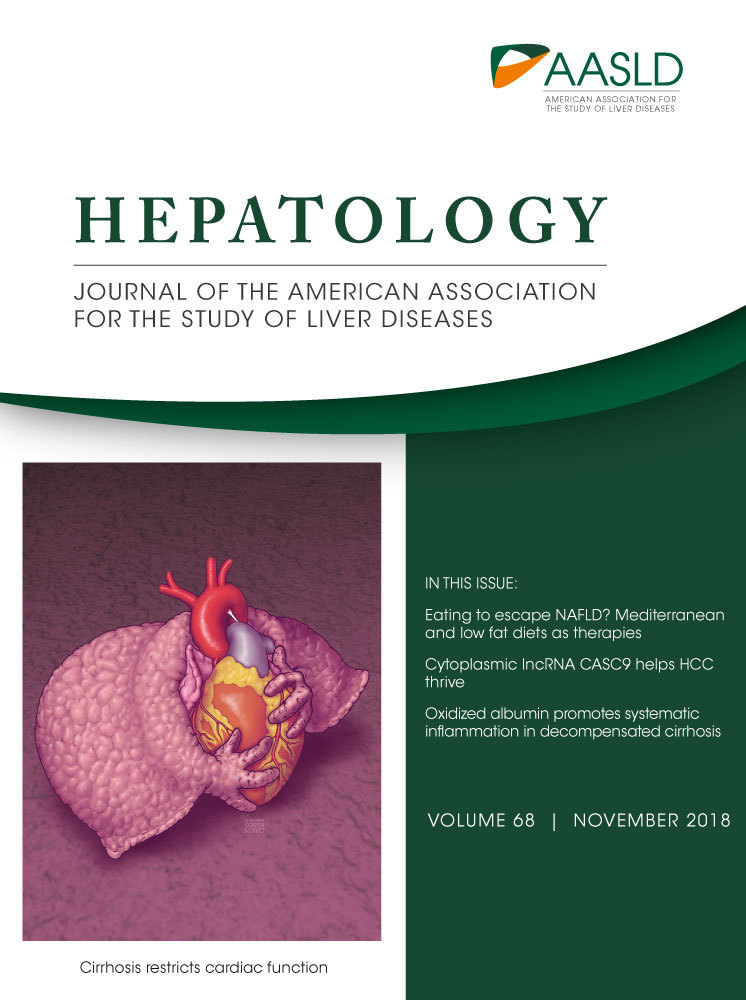CD2-Associated Protein Contributes to Hepatitis C, Virus Propagation and Steatosis by Disrupting Insulin Signaling
ADDRESS CORRESPONDENCE AND REPRINT REQUESTS TO:
Bixiang Zhang, M.D., Ph.D.
Hepatic Surgery Center, Tongji Hospital, Tongji Medical College, Huazhong University of Science and Technology
1095 Jiefang Avenue
Wuhan, 430030, China
E-mail: [email protected]
or
Chaoyang Li, Ph.D.
Center for Molecular Virology, Wuhan Institute of Virology, State Key Laboratory of Virology, Chinese Academy of Sciences
44 Xiao Hong Shan Zhong Qu
Wuhan, 430071, China
E-mail: [email protected]
Abstract
Chronic hepatitis C virus (HCV) infection can result in steatosis, a condition displaying aberrant accumulation of neutral lipid vesicles, the component of lipid droplets (LDs), which are essential for HCV assembly. However, the interplay between HCV infection and steatosis remains unclear. Here, we show that HCV-infected cells have higher levels of CD2-associated protein (CD2AP), which plays two distinct, yet tightly linked, roles in HCV pathogenesis: Elevated CD2AP binds to nonstructural protein 5A (NS5A) and participates in the transport of NS5A to LDs to facilitate viral assembly; Up-regulated CD2AP also interacts with casitas B-lineage lymphoma (b) (Cbl/Cbl-b) E3 ligases to degrade insulin receptor substrate 1 (IRS1), which, in turn, disrupts insulin signaling and increases LD accumulation through the IRS1/protein kinase B (Akt)/adenosine monophosphate-activated protein kinase (AMPK)/hormone-sensitive lipase (HSL) signaling axis to accommodate viral assembly. In the HCV-infected mouse model, CD2AP expression is up-regulated during the chronic infection stage and this up-regulation correlates well with liver steatosis. Importantly, CD2AP up-regulation was also detected in HCV-infected human liver biopsies showing steatosis compared to non-HCV-infected controls. Conclusion: CD2AP is indicated as a protein up-regulated by HCV infection, which, in turn, stimulates HCV propagation and steatosis by disrupting insulin signaling; targeting CD2AP may offer an opportunity for alleviating HCV infection and its associated liver pathology. (Hepatology 2018;XX:XXX-XXX.)
Abbreviations
-
- ACC1/2
-
- acetyl-CoA carboxylases 1 and 2
-
- Akt
-
- protein kinase B
-
- AMPK
-
- adenosine monophosphate kinase
-
- BioID
-
- proximity-dependent biotinylation method
-
- BirA*
-
- BirA (R118G)-HA
-
- Cbl/Cbl-b
-
- casitas B-lineage lymphoma (b)
-
- CD2AP
-
- CD2-associated protein
-
- Erk
-
- extracellular signal-regulated kinase
-
- HA
-
- hemagglutinin
-
- HCC
-
- hepatocellular carcinoma
-
- HCV
-
- hepatitis C virus
-
- HSL
-
- hormone-sensitive lipase
-
- Ig
-
- immunoglobulin
-
- IHC
-
- immunohistochemistry
-
- IRS1
-
- insulin receptor substrate 1
-
- JFH1
-
- Japanese fulminant hepatitis type 1
-
- LDs
-
- lipid droplets
-
- LS
-
- liver steatosis
-
- NS5A
-
- nonstructural protein 5A
-
- OA
-
- oleic acid
-
- p
-
- phosphorylated
-
- SH3
-
- Src homology 3
Hepatitis C virus (HCV) infects approximately 180 million people worldwide, causing serious chronic liver diseases such as steatosis, liver cirrhosis, and, eventually, hepatocellular carcinoma (HCC).1 Although a myriad of host factors have been reported to regulate viral propagation from entry to release of infectious particles,2-4 it is not fully understood how chronic HCV infection causes steatosis.
Lipid droplets (LDs), an organelle composed of a single phosphor-lipid layer,5 participate in many biological processes, such as energy storage and lipid metabolism.6 HCV uses LDs as hubs for assembly.7, 8 HCV proteins, especially nonstructural protein 5A (NS5A) and HCV core protein, are in close proximity to LDs in HCV-infected cells.9, 10 Transport of core and NS5A proteins to LDs depends on interactions between viral proteins, such as NS5A, and cytoskeletal filaments, such as actin and microtubules.11, 12
The goal of our studies was to better understand how HCV controls LD accumulation and contributes to liver pathology. We applied the proximity-dependent biotinylation (BioID) method to find NS5A interacting proteins in situ.13 One of the identified proteins was CD2-associated protein (CD2AP), an adaptor protein that is known to bind capping protein and regulate actin polymerization.14 We further show that CD2AP facilitates HCV propagation by two mechanistically linked pathways: participating in transporting NS5A to LDs and disrupting insulin signaling to boost more hubs for HCV assembly. In transgenic ICR mice infected with HCV, CD2AP up-regulation is detected in hepatocytes during the chronic stage of infection, concurrent with the appearance of steatosis. Importantly, levels of CD2AP are also up-regulated in liver biopsies from HCV-infected patients showing steatosis. Thus, our study indicates a link between CD2AP, HCV infection, and steatosis.
Materials and Methods
Materials
Cell cultures, viruses, plasmids, and reagents are described in the Supporting Information.
Animal Model
Eight- to 12-week-old age- and sex-matched littermates of human CD81 and occludin transgenic ICR mice were used for in vivo study and infected with HCV as described.15 Mice were tail-vein injected with HCV J399EM (tissue culture infective dose, 50 = 1 × 108/mL; 1 mL in 1-2 minutes to avoid liver injury). Mouse blood (0.1 mL) and liver tissues (0.1 g) were collected to quantify HCV genomic RNA at the indicated time. Five mice at each time point were infected with HCV. Two to three HCV infection-confirmed mice were used for further analysis. One of the noninfected mice at each time point was used as negative control. Data collection and data analysis were performed by different persons in a blinded manner. Use of animals was approved by the Institutional Review Board of Wuhan Institute of Virology, Chinese Academy of Sciences (Wuhan, China).15
Human Subjects
Seventy-two serologically confirmed HCV-infected human liver biopsies were obtained from resected liver tissues containing HCC, hemangioma, or cholangiocarcinoma from patients at the Tongji Hospital (Wuhan, China) and Eastern Hepatobiliary Surgery Hospital (Shanghai, China; patients’ information in Supporting Table S1). No biopsies were obtained from executed prisoners or other institutionalized persons. Liver samples from HCV/HBV (hepatitis B virus) coinfection were excluded. Twelve non-HCV- and non-HBV-infected control specimens were obtained from normal regions of liver adjacent to resected hemangioma (patients’ information in Supporting Table S1). Biopsies were scored for steatosis, cirrhosis, and HCC by two pathologists, Changshu Ke (M.D., Ph.D.) and Yu Hu (M.D., Ph.D.; Department of Pathology, Tongji Hospital). Among the 72 biopsies, 53 also had HCC, 7 cases did not show steatosis and cirrhosis, 17 cases showed only steatosis, 20 cases showed steatosis and cirrhosis, and 4 cases showed only cirrhosis. Some cases could not be determined and thus were excluded. Informed consent was obtained from all subjects. Use of liver sections was approved by the Institutional Review Board of Wuhan Institute of Virology, Chinese Academy of Sciences (Approval Number: WIVH28201601).
Methods of IN VITRO Assays, Statistical Analysis
In vitro assays and statistical analysis are described in the Supporting Information.
Results
HCV NS5A BINDS CD2AP
HCV NS5A plays an important role in HCV propagation. To identify proteins participating in HCV propagation, Huh7 cells with the NS5A-BirA*-HA construct (Fig. 1A) were cultured with or without biotin; more biotin-labeled proteins were detected in cells cultured with biotin (Fig. 1A). Several bands presented only in samples with biotin were sequenced and identified (Supporting Table S2). Among those proteins, CD2AP is an adaptor protein with three Src homology 3 (SH3) domains. Conversely, NS5A has several proline-rich motifs that are reported to bind the SH3 domain.16 Structural information thus suggests that CD2AP might interact with NS5A. Furthermore, the association of HCV replication complexes with actin has been shown depending on NS3 and NS5A interaction,17 and CD2AP can regulate actin organization.18 We thus focused on studying interactions between CD2AP and NS5A.
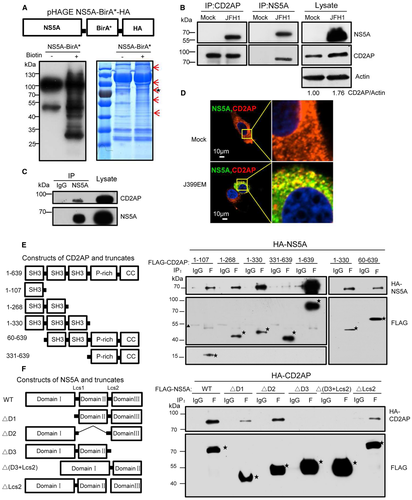
We found that CD2AP indeed interacted with NS5A (Supporting Fig. S1A), but not core protein (Supporting Fig. S1B) in vitro. In HCV Japanese fulminant hepatitis type 1 (JFH1)-infected cells, anti-CD2AP antibody pulled down NS5A and CD2AP (Fig. 1B). Conversely, anti-NS5A antibody also pulled down CD2AP and NS5A (Fig. 1B). Copurification was not observed with an isotype control mouse immunoglobulin (Ig)G2a (Fig. 1C). In addition, we observed colocalization of CD2AP and NS5A in cells infected with HCV-J399EM (Fig. 1D), the HCV 2a strain in which NS5A is enhanced green fluorescent protein tagged. Thus, in HCV-infected cells, CD2AP interacts with NS5A. More important, levels of CD2AP were consistently up-regulated in infected cells compared to mock-infected cells (Fig. 1B).
Domain III of NS5A Interacts with SH3 Domain of CD2AP
To investigate which domain bound NS5A, a panel of FLAG-tagged CD2AP mutants was generated (Fig. 1E) and coexpressed with hemagglutinin (HA)-tagged NS5A in 293T cells. By co-immunoprecipitation (Co-IP), CD2AP containing at least one SH3 domain was able to bind NS5A, but CD2AP mutant lacking all three SH3 domains did not (Fig. 1E). NS5A contains an N-terminal amphipathic helix, three domains (I, II, and III), separated by two low-complexity sequences.19 We generated a series of NS5A mutants and found that when domain III of NS5A was deleted, it failed to bind CD2AP (Fig. 1F). Therefore, domain III of NS5A can bind the SH3 domains of CD2AP.
CD2AP Participates in the Transport of NS5A to LD
To investigate the function of the binding between CD2AP and NS5A, we expressed an mCherry-tagged full-length CD2AP or CD2AP lacking all SH3 domains in Huh7.5.1 cells. After infecting these cells with HCV-J399EM, we observed that full-length CD2AP, but not truncated CD2AP, colocalized with NS5A (Fig. 2A). We then performed live cell tracking of the colocalized NS5A/CD2AP complex. The trajectory and velocity of the complex supported that CD2AP and NS5A indeed comigrated (Fig. 2B; Supporting Movie S1).

HCV particles travel along actin filaments.20 Motility of CD2AP in podocytes depends on actin polymerization.21 Others have reported that transport of the HCV NS5A to LDs depend on microtubules.12, 17, 22 To address whether cotransport of NS5A and CD2AP was actin or microtubule dependent, we cultured HCV-infected cells with either cytochalacin B (an actin polymerization inhibitor) or colchicine (a microtubulin polymerization inhibitor). Live cell tracking of NS5A and CD2AP showed that cytochalacin B reduced the colocalization of NS5A and CD2AP (Fig. 2C). However, colchicine did not reduce the colocalization, but blocked their co-movement (Fig. 2D; Supporting Movie S2). Four hours after removing cytochalacin B, colocalization of CD2AP and NS5A was restored (Fig. 2C). However, removal of colchicine did not restore NS5A/CD2AP comigration (movie not shown). These results suggest that NS5A and CD2AP colocalization is actin dependent and cytochalacin B treatment is reversible. Co-movement of the NS5A/CD2AP complex is microtubule dependent and colchicine treatment is irreversible.
Next, we investigated whether CD2AP participated in transport of NS5A to LD. We established two CD2AP-silenced Con1 cell lines (Supporting Fig. S2, c4# and c6#). Con1 cells support the subgenomic replication of HCV RNA, but do not support HCV assembly and production of virus particles.23 Silencing CD2AP did not affect the total level of NS5A, but reduced the association of NS5A with fractionated LDs (Fig. 2E). Purity of LDs was confirmed by the absence of calnexin, a marker for endoplasmic reticulum (ER), and the presence of adipose differentiation-related protein, a marker for LDs (Fig. 2E). Thus, these results suggest that binding between NS5A and CD2AP is actin polymerization dependent and NS5A/CD2AP complex may be transported to LDs in a microtubule-dependent manner.
Silencing CD2AP Reduces the Level of LDs
Because down-regulation of CD2AP diminished NS5A association with LDs in Con1 cells, we next investigated whether the phenomenon could be observed in Huh7.5.1 cells infected with HCV by generating two stably CD2AP-silenced cell lines (Supporting Fig. S3A, 4# and 6#). Immunofluorescent staining showed that less NS5A was found on LDs in CD2AP-silenced cells after infection with HCV (Fig. 3A). Surprisingly, levels of LDs were also reduced after CD2AP silencing (Fig. 3A). To investigate whether LD levels are enhanced by CD2AP expression or simply attributed to HCV infection, we stained LDs in those cells without HCV infection. We found that the level of LDs was reduced in CD2AP-silenced cells treated with or without oleic acid (OA), which can stimulate LD formation by activating the long-chain fatty acid receptor, free fatty acid receptor 4 (Fig. 3B).24 To prove there is a functional interplay between CD2AP and LD accumulation, we reintroduced HA-tagged CD2AP back into CD2AP-silenced cells (Supporting Fig. S3B). CD2AP-rescued cells (6#-res) had more LDs than control (6#-NC; Fig. 3C). Therefore, in addition to targeting HCV components to LDs, CD2AP also plays a role in boosting LD level.
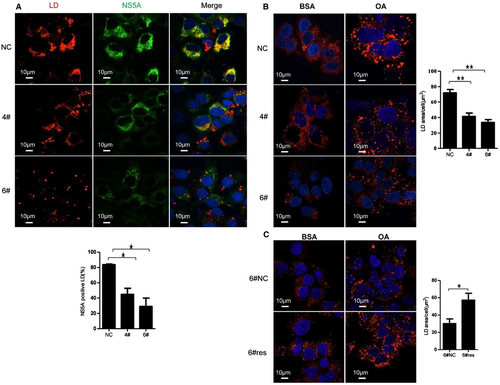
CD2AP Increases Insulin Receptor Substrate 1 Ubiquitination by Engaging Casitas B-Lineage Lymphoma (b) E3 Ubiquitin Ligases
We then investigated the mechanism of CD2AP regulating LD accumulation. Level of LDs is modulated by insulin signaling.25, 26 To study whether CD2AP boosted LD level through insulin signaling, we detected the expression of insulin receptor and insulin receptor substrate 1 (IRS1) in CD2AP-silenced cells. We found that levels of total IRS1, but not total insulin receptor, were obviously up-regulated (Fig. 4A). However, there was no difference for IRS1 mRNA levels between control and CD2AP-silenced cells (Supporting Fig. S4A). Hence, expression of IRS1 is likely regulated at the protein level. We found that after 2 hours of treatment with proteasome degradation inhibitor MG132, but not other inhibitors, such as NH4Cl/3-methyladenine/chloroquine, level of IRS1 was increased (Supporting Fig. S4B). These results suggest that IRS1 stability may be regulated by protein ubiquitination. Furthermore, MG132 treatment increased much more IRS1 in wild-type cells than in CD2AP-scilenced cells (Fig. 4B). These results implicate that CD2AP down-regulation may diminish IRS1 ubiquitination. To prove this hypothesis, we purified a similar amount of IRS1 from CD2AP-silenced and control cells, and found that CD2AP down-regulated cells indeed showed less ubiquitination (Fig. 4C). Thus, CD2AP affects IRS1 level by modulating its ubiquitination. However, we could not exclude the possibility that some IRS1 might be degraded in a ubiquitin-independent manner.
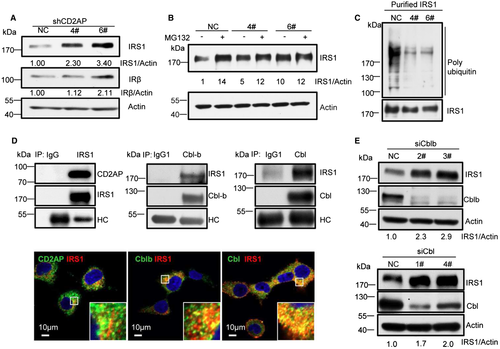
We then investigated how CD2AP regulated IRS1 ubiquitination. In Huh7.5.1 cells, IRS1 copurified and colocalized with CD2AP (Fig. 4D). Because IRS1 is a client of several E3 ubiquitin ligases27, 28 and CD2AP is known to interact with Cbl family E3 ligases,29, 30 we then investigated whether IRS1 interacted with casitas B-lineage lymphoma (b) (Cbl/Cbl-b) E3 ligases. We found that Cbl/Cbl-b copurified and colocalized with IRS1 (Fig. 4D). To address whether Cbl/Cbl-b ubiquitinated IRS1, we silenced Cbl/Cbl-b in Huh7.5.1 cells. Accordingly, levels of IRS1 were up-regulated (Fig. 4E). Thus, CD2AP promotes IRS1 ubiquitination and degradation by engaging Cbl/Cbl-b E3 ligases.
CD2AP Disrupts IRS1 Signaling to Boost LD Level
Because CD2AP promotes IRS1 degradation, we then investigated whether CD2AP influenced LD formation by the IRS1 signaling pathway, which affects lipid metabolism through the IRS1/phosphatidylinositol 3-kinase (PI3K)/protein kinase B (Akt) axis.31, 32 In CD2AP-silenced cells, the level of phosphorylated (p)-Akt (S473), but not p-Erk (extracellular signal-regulated kinase) was increased (Fig. 5A). Akt is a negative regulator of adenosine monophosphate kinase (AMPK).33 Then, we blotted for AMPK and found that level of p-AMPK (T172) was reduced in CD2AP-silenced cells (Fig. 5A). Activation of AMPK regulates many enzymes in lipid metabolism, such as acetyl-CoA carboxylases 1 and 2 (ACC1/2), adipose triglyceride lipase (ATGL), sterol regulatory element-binding protein 1 (SREBP-1), and hormone-sensitive lipase (HSL).34, 35 Binding of HSL to p-perilipin A on the surface of LD causes hydrolysis of LDs.36 AMPK phosphorylates S554, inactivating the lipase activity of HSL.37 We found that levels of p-HSL (S554), a marker of HSL inactivation, were reduced in CD2AP-silenced cells (Fig. 5A). Furthermore, silencing CD2AP did not affect other proteins involved in lipid metabolism, such as p-ACC1/2, ACC1/2, SREBP1, and ATGL (Supporting Fig. S5). To confirm that HSL (S554) is phosphorylated by AMPK, we treated cells with dorsomorphin, an AMPK inhibitor. Dorsomorphin reduced levels of p-AMPK (T172) and p-HSL (S554; Fig. 5B). To further prove that CD2AP disrupts IRS1 signaling by the PI3K-Akt pathway, we reintroduced CD2AP into CD2AP-silenced cells; the level of p-Akt (S473) was reduced (Fig. 5C, compare lane 3 to lane 4). Considering that CD2AP functionally rescued p-Akt (Fig. 5C) and LD levels (Fig. 3C) when reintroduced into CD2AP-silenced cells, these results provided strong evidences that enhanced CD2AP affects lipid metabolism by the IRS1-Akt-AMPK-HSL axis, causing inactivation of HSL to increase LD accumulation.
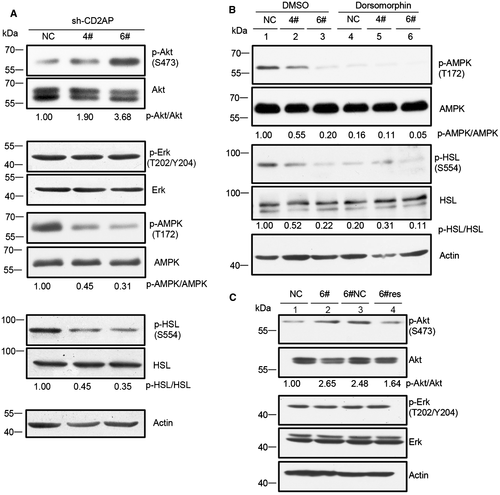
CD2AP Silencing Inhibits HCV Propagation Independent of Virus Entry, Subgenomic Replication, and Internal Ribosomal Entry Site-Dependent Translation
Because silencing CD2AP affects LD accumulation and NS5A transport to LDs, we posited that CD2AP down-regulation should affect HCV propagation. First, we infected CD2AP-silenced Huh7.5.1 cells with HCV-JFH1 and found that CD2AP down-regulation did not affect cell viability (Supporting Fig. S6A), but reduced intracellular total HCV-RNA level, protein level, and supernatant RNA copy numbers (Fig. 6A), and the reduction seems to be correlated with level of CD2AP reduction. In addition, silencing CD2AP also decreased the JFH1-Luc-5AGFP reporter virus activity (Fig. 6B) and CD2AP-rescued cells (6#-res) could recover HCV-RNA and protein level (Fig. 6C). Thus, CD2AP indeed regulates HCV propagation.
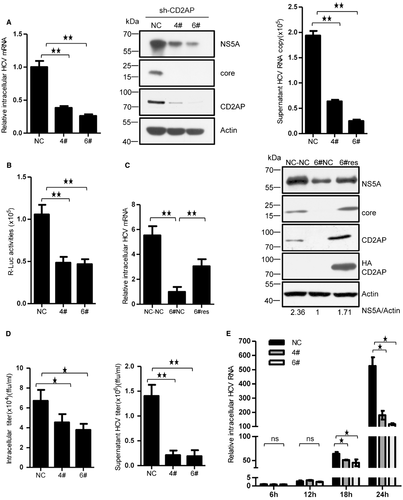
We then tried to identify the step(s) affecting HCV replication after CD2AP silencing. We found that silencing CD2AP did not affect HCV entry (by pseudovirus assay; Supporting Fig. S6B), subgenomic replication in Con1 cells, which do not support HCV assembly (Supporting Fig. S6C and Fig. 2E), and HCV internal ribosomal entry site-dependent translation (Supporting Fig. S6D). However, intracellular and supernatant HCV titers (Fig. 6D) were reduced in CD2AP-silenced cells infected with JFH1. This suggested that CD2AP silencing impaired production of infectious virions in steps other than virus entry, subgenomic replication, and RNA translation. We further performed one single-cycle assay to determine which step of HCV infection was affected by CD2AP silencing. We found that HCV could complete one single cycle between 12 and 18 hours postinfection (Supporting Fig. S7A) and CD2AP silencing significantly reduced intracellular HCV RNA 18 hours, but not 12 hours, postinfection (Fig. 6E). However, we did not detect NS5A protein expression until 24 hours postinfection (Supporting Fig. S7B), probably attributed to low sensitivity of immunoblotting. These results, together with the observation that less LD accumulation and less NS5A was found on LDs after CD2AP silencing (Fig. 3), supported that HCV assembly might be impaired in CD2AP-silenced cells. However, it is also possible that steps other than HCV assembly are also impacted by CD2AP down-regulation. Thus, HCV infection increased CD2AP expression to enhance HCV propagation.
CD2AP Up-Regulation Correlates with Steatosis in an Animal Model and in Human Biopsies
HCV is known to cause steatosis, and CD2AP is up-regulated in HCV-infected cells and enhanced CD2AP could stimulate LD accumulation, a requirement for steatosis. We then investigated whether steatosis and CD2AP up-regulation could be observed in a human CD81 and occludin transgenic ICR mouse model.15 Based on liver and blood HCV-RNA copy number, the first week after HCV infection represented the acute infection stage (Fig. 7A). At this time, there was little CD2AP staining in the liver (Fig. 7B). In contrast, CD2AP expression became highly noticeable from the first to fourth month during the chronic infection stage, when lipids began to accumulate and steatosis was evident (Fig. 7B, arrows indicate steatosis). Thus, up-regulation of CD2AP correlates with manifestation of steatosis.
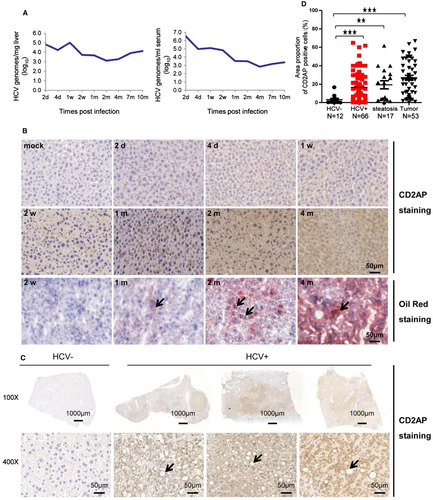
Finally, we stained 72 liver biopsies from HCV-infected patients and 12 liver biopsies from non-HCV-infected controls for CD2AP. We found CD2AP immunohistochemistry (IHC) staining was faint or undetectable in most of the non-HCV-infected controls, whereas most of the 72 HCV-infected biopsies showed positive CD2AP staining (Fig. 7C,D). Most important, HCV-infected biopsies showing only steatosis or HCC also showed stronger CD2AP staining than non-HCV-infected hepatocytes (Fig. 7D). Thus, HCV infection activated CD2AP expression in the mouse model and human subjects, and the up-regulation correlates well with liver steatosis (LS).
Discussion
Liver pathologies, such as steatosis, are affected by many factors.38-40 Here, we provide insights into the propagation of HCV and steatosis caused by chronic HCV infection. We identify a host protein, CD2AP, as being stimulated by HCV infection and pivotal in HCV propagation and lipid metabolism. CD2AP participates in cytoskeleton reorganization and trafficking of cellular organelles and vesicles.18, 21 In HCV-infected cells, the SH3 domain of CD2AP binds domain III of NS5A (Fig. 1). Binding of CD2AP to NS5A delivers NS5A toward LDs for HCV assembly. We posit that during HCV assembly, trafficking of the CD2AP/NS5A complex to LDs is a two-step process. First, CD2AP meets NS5A in an actin-filament–dependent manner. Subsequently, NS5A is transported to LDs through the microtubule (Fig. 2). At this time, the molecular mechanism mediating these two steps is unknown. Given that CD2AP can bind small G-coupled proteins that are important in vesicle formation and migration,41 it is likely that additional host proteins, such as motor proteins and small GTPases, are involved in the transport process.
Unexpectedly, CD2AP also regulates the levels of LDs. In HCV-infected cells, CD2AP modulates the activity of IRS1 by securing Cbl/Cbl-b E3 ligases, enhancing IRS1 ubiquitination, and augmenting IRS1 degradation by the proteasome (Fig. 4), which then regulates the Akt-AMPK-HSL signaling axis. Accordingly, levels of LDs, IRS1, and p-Akt are correlated with CD2AP (Figs. 3-6).
When CD2AP is silenced, production of infectious HCV particles is also decreased (Fig. 6D). We postulate that reduction of infectious HCV particles is attributed to diminished transport of NS5A to LDs and reduced levels of LDs for virus assembly (Figs. 2 and 3). This hypothesis is supported by the observation that when CD2AP was rescued, production of HCV was also restored (Fig. 6C).
In an HCV infection transgenic ICR mouse model, levels of HCV RNA were detected in liver and serum of infected mice 2 days postinfection (Fig. 7A). However, hepatocyte CD2AP staining in these mice did not appear until much later, at around 1 month postinfection, a time when steatosis began to appear (Fig. 7B). Thus, CD2AP up-regulation may contribute to steatosis. In cells, up-regulation of CD2AP occurs within days, but in infected animals, this up-regulation can only be observed at the chronic stage of infection. The reason for this difference is not known. One possibility is that in the cell model, the hepatoma cells already express high levels of CD2AP, whereas the normal hepatocyte has no detectable CD2AP. Titers of the HCV used for in vitro infection and in vivo infection may also contribute to the difference. Furthermore, immunoblotting is more sensitive than IHC staining; a slight increase in CD2AP level may escape detection by immunostaining.
In human liver biopsies, only 2 of the 12 noninfected control tissues showed discernable CD2AP expression (Fig. 7D), whereas most of the HCV-infected peritumor biopsies showed positive CD2AP staining. The reason why some of the biopsies from HCV-infected individuals are CD2AP negative is not clear at this time. These patients may express CD2AP that is beyond the detection limit of IHC, or they are at an earlier stage of infection. Most important, CD2AP expression is also significantly higher in liver biopsies with steatosis than in HCV-negative liver biopsies, further proving that CD2AP may contribute to steatosis (Fig. 7D).
In summary, we propose a model in which CD2AP regulates HCV propagation and steatosis (Fig. 8). HCV infection up-regulates CD2AP to facilitate HCV propagation by distinct methods: On one hand, CD2AP binds NS5A by actin to form a complex that is then transported to LDs in a microtubule-dependent manner. On the other hand, CD2AP recruits Cbl/Cbl-b E3 ligases to promote the ubiquitination and degradation of IRS1, which causes a decrease in p-Akt, a negative regulator of AMPK. When p-Akt is reduced, the level of p-AMPK is increased. An increase in p-AMPK promotes phosphorylation and inactivation of HSL. Inactivation of HSL reduces LD hydrolysis, boosting LD levels, providing more hubs for HCV assembly. At present, we cannot exclude other possible ways in which CD2AP might affect HCV propagation. In the HCV-infected mouse model and human subjects, CD2AP expression is up-regulated, and this up-regulation correlates well with LS. Thus, HCV infection-induced CD2AP expression results in a vicious cycle for HCV infection. However, how the vicious cycle is blocked by host responses remains to be investigated. Finally, the interplays between HCV infection, steatosis, and CD2AP expression are complicated. Elucidating these interplays will require studying a much larger cohort of patients as well as an additional animal model.
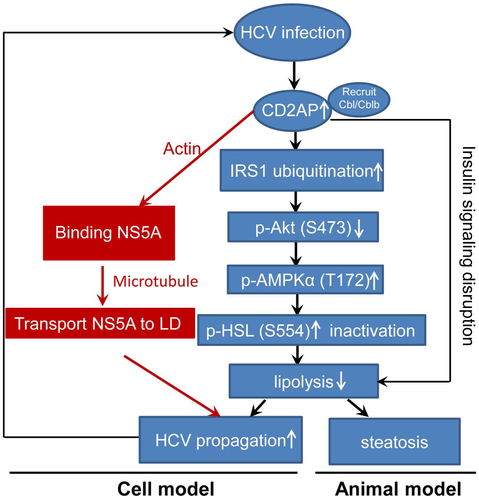
Although our study has added details into the biology of the HCV life cycle and liver pathology, many important questions remain to be explored. For example, how is CD2AP up-regulated by HCV infection? Does the detection of CD2AP have any prognostic values in HCV-infected patients? Furthermore, systematic studies of other already identified proteins will impart additional details to our understanding of HCV biology. Likewise, using a different HCV-encoded protein as the “bait” in the BioID approach, we may identify additional host proteins that are important in the HCV life cycle. Finally, a myriad of studies suggested that lowering of IRS1 level contributed to insulin resistance in type II diabetes.42 Our finding that CD2AP regulates IRS-1 turnover may provide a potential therapeutic target to treat type 2 diabetes, in addition to curtailing HCV-associated pathology.
Supported by the “Personalized Medicines—Molecular Signature-based Drug Discovery and Development”, Strategic Priority Research Program of the Chinese Academy of Sciences (XDA12010309), by National Key R&D Program of China (2018YFA0507201), by the National Basic Research Priorities Program of China (No. 2013CB911102), and by the National Natural Science Foundation of China (31670170).
Potential conflict of interest
Nothing to report.
Acknowledgments
We thank Professors Xulin Chen and Rongge Yang (Chinese Academy of Sciences) for JFH1-Luc-5AGFP virus stocks and pNL4.3.lucRE, pcDNA3.1-E1E2 plasmids; Professor Cunyi Zheng (Wuhan University) for HCV NS5A plasmid; and Professor Charles M. Rice (Rockefeller University, Sacramento, CA) for NS5A (9E10) antibody. We also thank The Core Facility and Technical Support, Wuhan Institute of Virology for technique support (Dr. Ding Gao for Confocal; Ms. Juan Min for flow cytometry).



